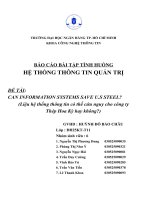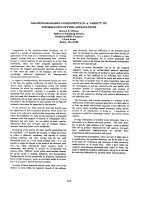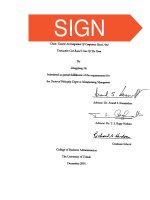Report Tourism Distribution Information System
Bạn đang xem bản rút gọn của tài liệu. Xem và tải ngay bản đầy đủ của tài liệu tại đây (220.02 KB, 8 trang )
Introduction
Nowadays, airline industry become is one of the most integral parts worldwide, not only the
major economic force based on its own operations, but also its contribution to relate commercial
sectors such as: aircraft manufacturing, tourism sectors... This paper has been divided into two
main parts. The first part basically introduced a traditional distribution system with the
relationship and related components of network as well as the key historic development in each
period of reservation network, including ARS- Airline Reservation System, CRS – Computer
Reservation System and GDS – Global Distribution System. The next paragraphs organized to
analyze how these distribution channel changes to adapt the new environment along with the
advancement of the Internet.
Computer information and distribution systems in the travel and
tourism industry and the diversification of business model to new
environment.
1. Computer information’s function and key historical development of traditional
distribution system
In general, there are three main stakeholders are influenced on the distribution within the tourism
and travel industry. The first of these is suppliers or service providers, including the tangible
products (airlines, accommodation providers, transportation companies and attraction & activity
providers) and the second is the service beneficiary or customers who have a partnership with the
first one. To some extent, intermediaries are the last components, aimed “to bring buyers and
sellers together, either to create markets where they previously did not exist or to make existing
markets work more efficiently and thereby to expand market size” (Wanhill, 1993, p. 189). Along
with travel agents or tour operators, the Internet has an important function in linking two sides of
stakeholder. The participant of the Internet and high technology system has given the consumer
greater opportunities in which they are able to freely pick and choose reasonable suppliers.
1
During much of development, the global airline industry deals with major technological
innovations. In 1946, American Airlines was a pioneer established the first electrical booking system
for managing seat inventory, named Availability Reservisor. It actually worked fine and airline
staff could make reservation easier. However, in spite of a huge innovation, which change the
history of airline reservation, it still brought some inconvenient in booking reservation, it was not
connected to any network. “Throughout the mid-1940s, reservation were recorded manually
using pencil to mark up different colored index card know as Tiffany cards” (Gary Inkpen, 1994,
p. 102), a clerk would complete a card or PNR (Passenger Name Record) and it would be slotted
into the board for that particular flight. Once all the slots were filled, the flight was full. All
bookings were relied on telegram as well able to communicate with city of departure so it's very
slow and labor intensive, for instance “… to complete a booking for a round trip reservation
from New York City to Buffalo required 12 different people performing more than a dozen
2
separate steps over a three hours period – longer than the flight itself took!” (Gary Inkpen, 1994,
p. 102)
As a consequence of the inefficacy of manual systems for the control of seat availability, in the
late 1950s, the period of technological advance significantly started with the goal of creating an
automated system for the capacity administration. American Airlines worked with IBM to
develop “Semi-Automated Business Research” (SABRE) launched in 1959 and it is also known
as ARS – Airline Reservation System. ARS contains information for one airline, separated from
other intermediaries as well as usable by a fixed number of staffs in the network. Until 1964,
SABRE was expanding and telecommunications network set up completed; create the largest
real-time data processing system in the world at that time.
Furthermore, it is highly appealing aim in the industry using a system to track information and
enhanced productivity among a consortium of US carriers, therefore; ten year later SABRE joint
in an improvement program in 1974 and creating a CRS. Air travel information is linked, stored,
and retrieved from a network of CRS, used to manage inventory within a network of airline,
hotel or hospitality enterprise. The most noticeable feature of CRS is accessible by multiple
airlines; travel agents and it demonstrate more of a “global” focus.
In 1975, UA pulled out the consortium and they initiated sought to develop their own machine
reservation system. At that time, IBM launched PARS (Programmed Airline Reservation System)
with airlines such as Continental, Delta & Eastern, TWA & United also signing up to use PARS
as a base system following the failure of their own systems. In Jan 1976, United installs CRS
called Apollo into travel agencies. Then, American Airline placed SABRE into retail travel
agencies free of charge. This service helped travel agents automatically generate their own airline
reservations for their clients and gave the major airlines significantly increased sales exposure.
According to phase 2 in the following table, CRS was co-hosting another airline within the
system and it consequently creates the competitiveness. “Recognizing the cost reduction and
efficiency benefits of these automated systems, smaller carriers without the resources to finance
such developments began to contract out their seat inventory and reservation functions to the
CRS-owning airlines.” (George H. Stonehouse, Jonathan D. Pemberton, Claire E. Barber,
para.3).
3
Table 2. Phases of CRS/GDS development (based on Stonehouse et al., 2001)
As a result, CRS was used as a tool for competition that derived “Halo effects”, for example,
owned system was biased towards owning airline, allowed rivals to display their flight on
SABRE CRS for free but it came with a catch.
Besides issuing with bias of CRS and in order to increase product range as well as established an
automated system to meet the higher demand of storage and manage of all the information
related to not only flight, lodging availability but also other types of international tourism
products, CRS changed into a worldwide distribution system. A new and enlarged concept
Global Distribution System (GDS) was constituted in 1987.
4
In 1998, Dr Dimitrios Buhalis found that:
“By gradually expanding their geographical coverage, as well as by integrating both horizontally
(with other airline systems) and vertically (by incorporating the entire range of tourism products
and services, such as accommodation, car rentals, train and ferry ticketing, entertainment and
other provisions) … This enabled the display and purchasing of the majority of tourism products
online. As GDSs connect most tourism organizations with intermediaries around the world, they
lead the standardization processes and control a considerable market share.” (p. 5).
2. The diversification of business model to new environment.
There are four main popular GDSs: SABRE, APOLLO (also known as GALILEO),
WORLDSPAN and AMADEUS. In 1990, SABRE and APOLLO offered terminal access to the
European travel agent. Then, 11 European airlines brought into APOLLO GDS and improved the
first fully operational European GDS named GALILEO. GDS function is creating PNR and Back
Office integration, controlled the majority of airline distribution, therefore the airlines had little
other choice. “The structure of the tourism industry distribution system not only affects the
choices available to the consumer, but also the business models & marketing strategies of the
channel participants.” (John Kracht, Youcheng Wang, 1994). Under that circumstance, many
problems appear and strongly affect to GDS Companies, the issue will be discussed in the next
paragraph.
Along with the development of GDSs, the launch of the Internet and its rapid growth in
distribution cannot be denied as well as the advert of the Internet created golden opportunities for
the tourism industry. In more detail, phase 4 of table 2 indicated the general function of GDS
which manages all reservation activity and customers need to access the GDS to booking via
Internet. The first aspect to be discussed is that of good service and the advantages it brings to
the industry. “The GDSs have served airlines well for many decades. GDS’s security, reliability,
speed, and accuracy are among the best in any transactions-based industry.” (Henry H.
Harteveldt, 2012, p. 24). Currently, the Internet is an interactive tool for selling tourism products
compare to traditional system which often allows only one-way communication from suppliers to
consumers. It brings more flexible control authorization to distribution channels and dynamic
options for travelers; hence, tourism product is sold worldwide over the Internet is higher than
any other consumer product.
5
A further aspect to be considered is the competitiveness of GDS providers and the way they
solve their problem in response to new market. As of 1990s:Ownership change, airline divest
their GDS, rise of direct sales through Internet. GDS facing new entrants, airline reclaim their
ownership of the channel, LCC, new business model, GDS lose their market share
On the other hand, “The GDSs generated more than $9.6 billion in revenue and more than 1.1
billion transactions in 2008. That equates to just over 2,100 transactions per minute. The GDSs
are most often thought of as a distributed environment for airlines; more than 550 airlines and the
overwhelming majority of commercial airline fares and inventory are accessible via the GDSs.”
(TRAVDEX, 2010). Respectively, revenue of GDS came from booking fees charged to airline
and subscription fees paid by agencies which mainly earned from the commission paid by the
airlines.
Regarding to this issue, GDSs companies found that they are in the competition with the very
same airlines that created them. So GDSs intend to set up their own websites in an attempt to
distribute their product direct to the consumer and to avoid paying GDS fees. The very first steps
are selling their shares, following by many brightness improvements.
To some extent, in1996, Sabre made an initial public offering of 18 percent of its stock as well
listed on the New York stock exchange. Then, SABRE founded the web-based vendor
Travelocity.com - the industry’s leading online consumer travel web site, generate more than
$300million in revenues in 2001. Saber makes Travelocity a wholly owned subsidiary and
continually introduced many key products such as “Travelocity Business™” to serve corporate
travel agencies and business travelers, “MySabre™” - web-based agent booking platform that
provides agents and suppliers with new marketing opportunities at the point of sale.
In 2006, Sabre Holding shows that:
“Sabre Travel Network launched the Efficient Access Solution as a foundation for the company's
new portfolio of customizable end-to-end solutions for travel agents serving the corporate and
leisure travel segments, provides a balanced approach for addressing travel agents' requirements
for full content and airlines' desire to reduce costs.”
6
SABRE continuously got a significant feature, in 2010 Sabre launches industry’s first ecocertified hotel program, the Sabre air pricing, application is migrated to a new platform taking
airfare pricing, schedules and availability from a proprietary mainframe system to an open
system. Moreover, a lot of website leading the market was acquired: lastminute.com - Europe’s
leading online travel site, IgoUgo.com - travel community website, and launched the industry's
first keyword-based travel search engine.
Following the success, Galileo International became a publicly traded company listing on the
Chicago & New York stock exchanges in 1997. “Four years later, in October 2001, Galileo
became a subsidiary of Cendant Corporation in $1.8billion common stock and cash, forming the
cornerstone of Cendant's Travel Distribution Division.” (Galileo website).
Worldspan was looking for ways bypass GDS by creating own internet channels, named Orbits.
“In 2001, Orbitz LLC was launched on the Internet, using Worldspan as its Internet Booking
Engine, and in 2002, the launch of Worldspan ePricingSM made Worldspan the first GDS to
introduce a revolutionary new multi-server-based technology, offering an unprecedented
selection of pricing options to all of Worldspan’s customers.” (Samipatra Das, 2002)
Amadeus also became a public company, held shares by 4 European airlines: Iberia, Air France,
Lufthansa and SAS in 1999. “In 2006, Amadeus Ticketless Access was set up, enable low cost
carriers to participate in the GDS, reducing the cost and complexity associated with travel
agency sales. (Emma Kelly, 2009, p. 35). Ten years later, “Amadeus becomes the largest GDS
provider serving the worldwide travel and tourism industry, with an estimated market share of
37% in 2009.” (Videcom). As of December 2010, over 90,000 travel agencies worldwide use the
Amadeus system which gives access to book content from 435 airlines (including 60 low cost
carriers), 200 tour operators…
In order to give travel agents, the ability to provide options and become more efficient, be price
competitive, increase their profit, GDS companies run their portals where customers can view
their reservation held in GDS’s database by travel agents: www.viewtrip.com (Galileo),
www.virtuallythere.com (Sabre), www.checkmytrip.com (Amadeus).
7
Conclusion
In terms of diversification, these GDS companies change their ownership and pay more attention
on technological advancement. It has been said that the Internet and computer information bring
a lot of betterment to the non-smoke industry. In relation to the evolution of the Internet and
distribution channel network, travel agents are experts at selling airline products to their
customers, and they have keen insight into how to overcome obstacles. Over the past year, many
airlines have evolved their business model in an effort to raise profits. However, throughout the
innovation of distribution system in a long period, no longer own their traditional markets of the
travel agency & airline sectors, GDSs have experienced many challenges to cope with a world of
rapid changes.
8









